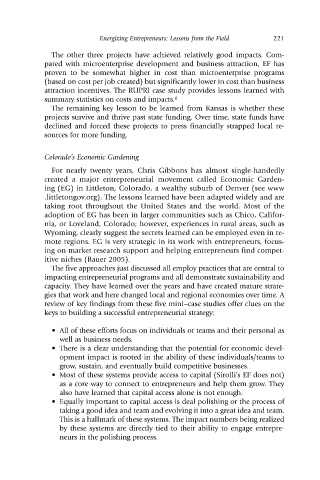Page 232 - 1-Entrepreneurship and Local Economic Development by Norman Walzer (z-lib.org)
P. 232
Energizing Entrepreneurs: Lessons from the Field 221
The other three projects have achieved relatively good impacts. Com-
pared with microenterprise development and business attraction, EF has
proven to be somewhat higher in cost than microenterprise programs
(based on cost per job created) but significantly lower in cost than business
attraction incentives. The RUPRI case study provides lessons learned with
summary statistics on costs and impacts. 6
The remaining key lesson to be learned from Kansas is whether these
projects survive and thrive past state funding. Over time, state funds have
declined and forced these projects to press financially strapped local re-
sources for more funding.
Colorado’s Economic Gardening
For nearly twenty years, Chris Gibbons has almost single-handedly
created a major entrepreneurial movement called Economic Garden-
ing (EG) in Littleton, Colorado, a wealthy suburb of Denver (see www
.littletongov.org). The lessons learned have been adapted widely and are
taking root throughout the United States and the world. Most of the
adoption of EG has been in larger communities such as Chico, Califor-
nia, or Loveland, Colorado; however, experiences in rural areas, such as
Wyoming, clearly suggest the secrets learned can be employed even in re-
mote regions. EG is very strategic in its work with entrepreneurs, focus-
ing on market research support and helping entrepreneurs find compet-
itive niches (Bauer 2005).
The five approaches just discussed all employ practices that are central to
impacting entrepreneurial programs and all demonstrate sustainability and
capacity. They have learned over the years and have created mature strate-
gies that work and here changed local and regional economies over time. A
review of key findings from these five mini–case studies offer clues on the
keys to building a successful entrepreneurial strategy:
• All of these efforts focus on individuals or teams and their personal as
well as business needs.
• There is a clear understanding that the potential for economic devel-
opment impact is rooted in the ability of these individuals/teams to
grow, sustain, and eventually build competitive businesses.
• Most of these systems provide access to capital (Sirolli’s EF does not)
as a core way to connect to entrepreneurs and help them grow. They
also have learned that capital access alone is not enough.
• Equally important to capital access is deal polishing or the process of
taking a good idea and team and evolving it into a great idea and team.
This is a hallmark of these systems. The impact numbers being realized
by these systems are directly tied to their ability to engage entrepre-
neurs in the polishing process.

